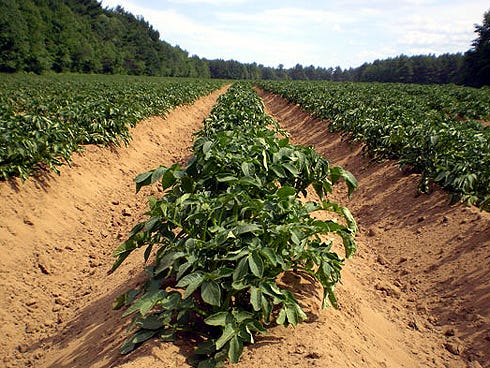
A University of Florida scientist has pinpointed Mexico as the origin of the pathogen that caused the 1840s Irish Potato Famine, a finding that may help researchers solve the $6 billion-a-year disease that continues to evolve and torment potato and tomato growers around the world.
A disease called “late blight” killed most of Ireland’s potatoes, while today it costs Florida tomato farmers millions each year in lost yield, unmarketable crop and control expenses.
For more than a century, scientists thought the pathogen that caused late blight originated in Mexico. But a 2007 study contradicted earlier findings, concluding it came from the South American Andes.
UF plant pathology assistant professor Erica Goss wanted to clear up the confusion and after analyzing sequenced genes from four strains of the pathogen, found ancestral relationships among them that point to Mexico as the origin.
“The pathogen is very good at overcoming our management strategies,” said Goss, a UF Institute of Food and Agricultural Sciences faculty member. “To come up with better solutions to late blight, we need to understand the genetic changes that allow it to become more aggressive. By understanding past changes, we can design new strategies that are more likely to be robust to future genetic changes.”
Goss and eight colleagues analyzed the genes of potato late-blight pathogens from around the world. Potato late blight, which flourishes in cool, damp weather, is caused by the pathogen phytophthora infestans.
Scientists sequenced four genes from more than 100 phytophthora infestans samples, plus four closely related species, to tease out the pathogen’s origin. Knowing the origin provides insight into its genetic diversity and the ways it adapts to different environments, Goss said
The pathogen also moved from other related species to the potato late in the evolutionary history of potatoes, she said, perhaps one reason potatoes are so susceptible to the disease and why finding a breeding-based solution to the disease has been so difficult.
The pathogen costs $6 billion a year globally between direct crop damage and spraying, she said. In Florida, it damages tomatoes far more than potatoes.
Florida farmers lose millions each year due to late blight, said Gene McAvoy, Hendry County Extension director, who has monitored late blight in Southwest Florida for years.
A late-blight pandemic in 2009 made the pathogen a household term in much of the eastern U.S. It made its way to the Northeast via tomatoes in big-box retailers. After planting the tomatoes, many home gardeners and organic producers lost most, if not all, of their crop, Goss said.
“Just when we think we’re on top of it, a new strain shows up,” she said. “New strains have repeatedly appeared in the U.S. that are more aggressive or resistant to fungicides. This pathogen just keeps coming.”
Goss wrote the paper, published online Monday by Proceedings of the National Academy of Sciences, with scientists from eight other university and government agencies.
This article originally appeared on Crestview News Bulletin: UF researcher's finding could help farmers stop potato, tomato disease
